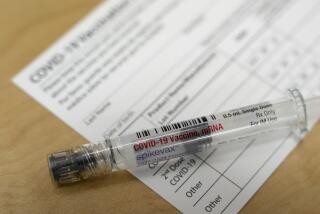Fight flu without pain
- Share via
A newly approved flu vaccine that’s squirted up the nose is likely to appeal to millions of Americans who avoid getting an annual flu shot, including some needle-phobic youngsters. The vaccine could potentially reduce the number of people who become seriously ill or die during the flu season. And having more people protected could lower the health costs associated with flu-related symptoms.
Earlier this month, the Food and Drug Administration approved the nation’s first inhaled vaccine, FluMist. It was specifically endorsed for use in healthy children, adolescents and adults ages 5 to 49, but not for those most vulnerable to flu complications, including the very young, the very old and those suffering from asthma and other chronic diseases.
Until further studies can be conducted showing that the vaccine is safe and effective for those patients, they’ll have to stick with the injectable vaccine.
Public health officials hope that with more healthy people using the inhaled vaccine, there will be fewer shortages of the injectable form.
Unlike the injectable vaccine, made from dead viruses, FluMist is the first flu vaccine made from weakened live viruses, which can make some people sick, especially those with weakened immune systems. And there is another difference. While the traditional vaccine costs around $10 to $15, a dose of FluMist, which has taken years of biotechnology research to develop and is difficult to manufacture, will cost about $46. Studies of more than 10,000 healthy children have found that those ages 5 to 8 require two doses, given at least six weeks apart, to develop protection; adults need only a single dose.
“This is a very exciting vaccine for a couple of reasons,” said Dr. Jay M. Lieberman, chief of pediatric infectious diseases at Miller Children’s Hospital in Long Beach. “First, because it’s given through the nose, it may be more acceptable to people who don’t want to get their annual flu shot. Second, the fact it’s a live viral vaccine that replicates in the nose means you get more local immunity.”
About 35 million to 50 million Americans get the flu each year. An injectable vaccine with dead viruses sparks the creation of antibodies in the blood that protect against the more serious consequences of influenza, such as pneumonia, which lead to hospitalization and an estimated 36,000 U.S. deaths each year. The inhaled vaccine is considered an advance because the weakened virus not only triggers creation of antibodies in the blood, but also multiplies in the upper airways, blocking regular flu viruses from getting a foothold there.
Although Lieberman said he wouldn’t mind taking the new vaccine, “I’m not sure how much I’d be willing to pay for it. I get my flu shot every year and I’m not afraid of flu shots.”
Cost may be a barrier to widespread use. Currently, the California Department of Health Services doesn’t know whether the federal Vaccine for Children program will supply FluMist for public health use in the 2003-2004 flu season. “They have not told us yet to what extent they’ll cover the vaccine; FluMist is four times the cost of the injectable vaccine,” said Norma Arceo, a department spokeswoman. She said the state is awaiting a request from the manufacturer to provide FluMist at a discount to the Medi-Cal plan, which provides healthcare to the poor. Once that paperwork is in, state officials would then decide whether to offer the inhaled vaccine as a Medi-Cal benefit, she said. The FDA on June 17 gave manufacturer MedImmune Inc. and Wyeth Pharmaceuticals the go-ahead to jointly market FluMist, which should be available for the flu season that begins this fall.
Some local pediatricians still aren’t sure whether they’ll be offering FluMist in coming months. Dr. John J. Mangoni, a pediatrician in private practice in Pasadena, said the doctors in his practice are awaiting guidance from the American Academy of Pediatrics. In general, he said, many health insurance plans won’t cover flu vaccinations for kids unless they have asthma or other chronic illnesses; as a result, parents often bear the cost. Before administering FluMist, Mangoni said he wants to know more about how the live inhaled vaccine compares with the dead, injectable form. Clinical trials, for example, found that when children under the age of 5 received FluMist, they had an increased rate of asthma and wheezing within 42 days of the vaccination, compared with those who got a placebo.
The national Centers for Disease Control and Prevention currently recommends flu vaccinations for people at high risk for flu complications: those 65 and older with chronic heart disease, lung disease or diabetes; health care workers; and young children and their families. But less than half of those who should get vaccinated each year actually do.
Lieberman said having the option of a nasal vaccine may help encourage more people to protect themselves.
“If there’s a child with asthma or a grandparent with chronic disease, you not only want to give them the flu shot, but also vaccinate the people they come into close contact with. Maybe their older siblings, or mom and dad, will be more willing to get the nasal spray vaccine.”






